Glasses Lens Material: Your Ultimate Guide

Reviewed by
Beck JinetteTypes of Lens Materials | Three Main Materials | Lens coatings and add-ons | Polycarbonate vs Plastic | Best material
There are many types of lens material available on the market today, read on to discover which lens is best for your vision and lifestyle!

There is much more to buying eyeglasses than what first meets the eye. It’s not just choosing the right frame, cool shape or funky colours. Glasses lens materials also play an important part in picking the right eyewear for you and your vision.
It may seem like a lot to take in, but this article will guide you through the different qualities of the best glasses lens material!
How many types of lens materials for glasses are there?
There are five main types of lens materials for eyeglasses and sunglasses. Each type of lens material can help correct refractive errors such as nearsightedness, farsightedness, astigmatism or presbyopia.
Before going into the different materials, it can be good to understand the index of refraction. Some materials are categorized by the index of refraction, which indicates how fast light travels through a given material.
Essentially, the higher the refractive index of a material, the slower light moves through it, which results in a more significant bending (refracting) of light rays. With a higher refractive index, less lens material is required to bend light to the same degree as a lens with a lower refractive index.
In other words, for any eyeglass prescription, a lens made of a material with a high-refractive index will be thinner than a lens made of a material with a lower refractive index.
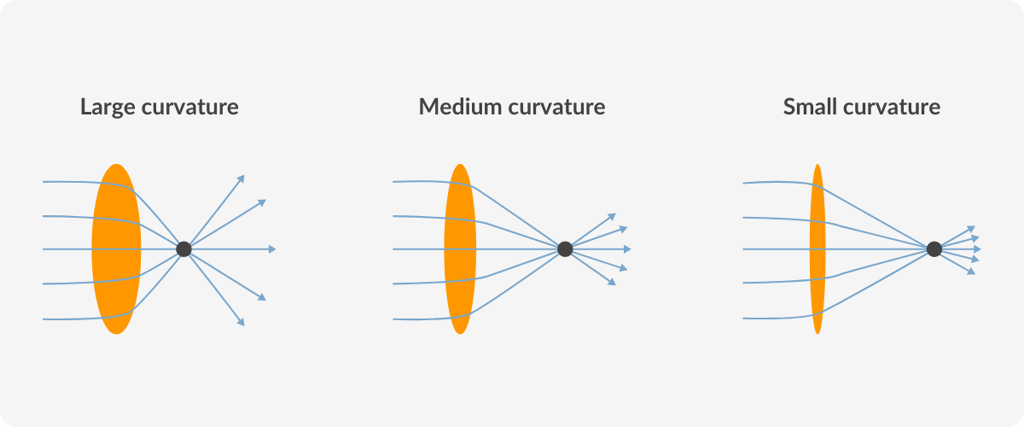
What are glasses lenses made of? The three main materials
Glass
Glass lenses are among the best glasses lens material. They provide visual clarity and are highly scratch resistant due to their hard surface.
However, glass lenses are heavy, thick and have a lower impact resistance. Of all the lens materials for glasses, glass must be specifically treated to comply with impact-resistant regulations and can not always fit in every frame design.
Plastic
Plastic (CR-39) is the standard glasses lens material. Plastic lenses offer great optics and vision correction for refractive errors and block out 80% of UV light. Compared to glass lenses, plastic lenses are lighter and less likely to shatter as easily.
However, CR-39 plastic lenses tend to be thicker than other plastic materials as they have a lower index of refraction.
High-Index
High-index lens materials are the thinnest and lightest of all glasses lenses material. They can be used for stronger prescriptions as they look more aesthetically pleasing with thinner lenses. High-index lenses bend light more efficiently as they have a higher index of refraction.
High-index lenses have superior optics and impact resistance, but these factors can depend on the type of high-index material used – glass or plastic. Like many other lens materials, high-index lenses provide quality UV protection.
Lens coatings and add-ons
Lens coatings can also be an important factor to keep in mind when choosing lens materials for your glasses.
With high-index lenses or polycarbonate, you’ll want to make sure you add an anti-reflective coating to avoid the lenses reflecting too much light – especially when driving.
With many lens materials, you can also get a zFORT® Blue light blocking add-on to help protect your eyes from harmful rays emitted by digital devices. In addition, Photochromic filters can be added to nearly all lens materials. With this, you have a pair of glasses that also function as sunglasses – 2-in-1!
Feel free to read our guide on lens coatings to learn more!
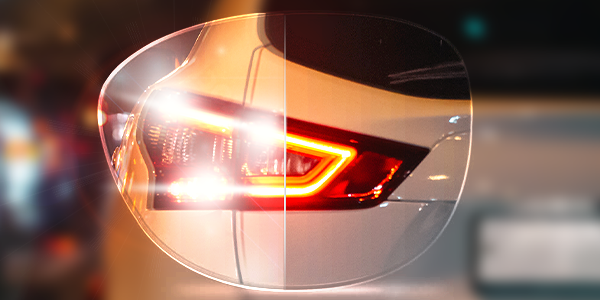
DID YOU KNOW?
Lens materials should be chosen based on your prescription, frames and lifestyle. If you think your lens is missing something, add a coating such as zFORT® Blue light blocking.
How do I know if my lenses are polycarbonate or plastic?
When shopping for glasses, it can take time to determine the type of lens material you are getting. You will probably ask yourself, what are glasses lenses made of? Hopefully, this article will provide some answers to that question. If you are happy with your current glasses lenses material and are wondering whether they are polycarbonate or plastic, there are a few ways to tell.
Polycarbonate glasses lenses are thinner than plastic glasses. In addition, they are usually lighter and more impact-resistant than plastic glasses lenses.
You can shop for premium plastic lenses on SmartBuyGlasses and if you’re looking for the same thinness as polycarbonate, high-index lenses are also available on the site.
What is the best eyeglass lens material?
To determine what lens material is best for you, you should have an eye test to determine the requirements of your vision correction. You should also always consult your eye doctor first to find the best suitable lens material for your specific vision correction.
Once you have consulted your optician and have your prescription, you should consider the following factors before making your purchase: Comfort, aesthetics, optics, safety and cost.
To summarise your options:
- Plastic lenses (CR-39) are the most affordable lens material and work better for weaker Rx.
- Glass lenses are also low-cost but are difficult to pair with certain frame designs and sizes.
- High index can work best if you want thinner lenses, but they do come at a higher cost.
- Polycarbonate lenses and Trivex lenses are similar but do present some differences.
If you wear glasses every day, you’ll want them to fit comfortably, look good and not weigh heavily on your face. Thinner lenses can tick all boxes. Thicker lenses are more noticeable in the frame and tend to be heavier. Thicker lenses are, however, more affordable and suitable for lower vision corrections.
You can browse through trendy eyewear on our site and find something to accommodate all of your eye needs. If you need more informative advice about how to choose the right glasses, speak to one of our certified online opticians today or visit our Optical Centre.
Glasses Lens Material: Your Ultimate Guide
Types of Lens Materials | Three Main Materials | Lens coatings and add-ons | Polycarbonate vs Plastic | Best Material

Reviewed by
Beck JinetteThere are many types of lens material available on the market today, read on to discover which lens is best for your vision and lifestyle!
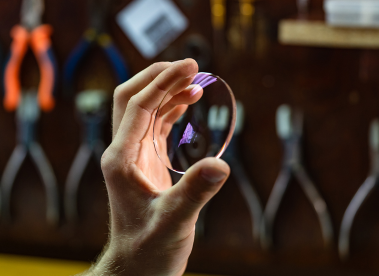
There is much more to buying eyeglasses than what first meets the eye. It’s not just choosing the right frame, cool shape or funky colours. Glasses lens materials also play an important part in picking the right eyewear for you and your vision.
It may seem like a lot to take in, but this article will guide you through the different qualities of the best glasses lens material!
How many types of lens materials for glasses are there?
There are five main types of lens materials for eyeglasses and sunglasses. Each type of lens material can help correct refractive errors such as nearsightedness, farsightedness, astigmatism or presbyopia.
Before going into the different materials, it can be good to understand the index of refraction. Some materials are categorized by the index of refraction, which indicates how fast light travels through a given material.
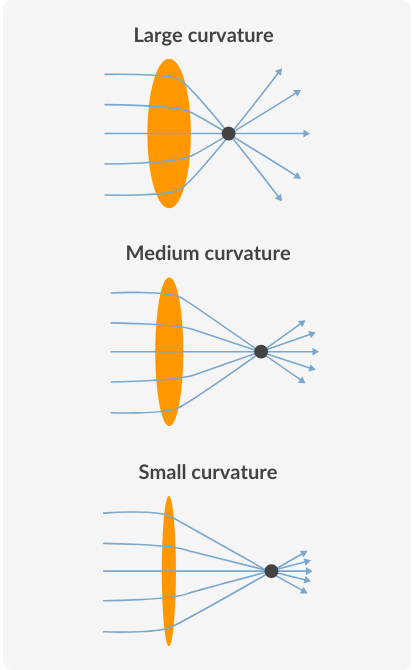
What are glasses lenses made of? The three main materials
Glass
Glass lenses are among the best glasses lens material. They provide visual clarity and are highly scratch resistant due to their hard surface.
However, glass lenses are heavy, thick and have a lower impact resistance. Of all the lens materials for glasses, glass must be specifically treated to comply with impact-resistant regulations and can not always fit in every frame design.
Plastic
Plastic (CR-39) is the standard glasses lens material. Plastic lenses offer great optics and vision correction for refractive errors and block out 80% of UV light. Compared to glass lenses, plastic lenses are lighter and less likely to shatter as easily.
However, CR-39 plastic lenses tend to be thicker than other plastic materials as they have a lower index of refraction.
High-Index
High-index lens materials are the thinnest and lightest of all glasses lenses material. They can be used for stronger prescriptions as they look more aesthetically pleasing with thinner lenses. High-index lenses bend light more efficiently as they have a higher index of refraction.
High-index lenses have superior optics and impact resistance, but these factors can depend on the type of high-index material used – glass or plastic. Like many other lens materials, high-index lenses provide quality UV protection.
Lens coatings and add-ons
Lens coatings can also be an important factor to keep in mind when choosing lens materials for your glasses.
With high-index lenses or polycarbonate, you’ll want to make sure you add an anti-reflective coating to avoid the lenses reflecting too much light – especially when driving.
With many lens materials, you can also get a zFORT® Blue light blocking add-on to help protect your eyes from harmful rays emitted by digital devices. In addition, Photochromic filters can be added to nearly all lens materials. With this, you have a pair of glasses that also function as sunglasses – 2-in-1!
Feel free to read our guide on lens coatings to learn more!
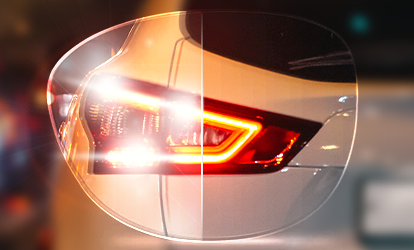
DID YOU KNOW?
How do I know if my lenses are polycarbonate or plastic?
When shopping for glasses, it can take time to determine the type of lens material you are getting. You will probably ask yourself, what are glasses lenses made of? Hopefully, this article will provide some answers to that question. If you are happy with your current glasses lenses material and are wondering whether they are polycarbonate or plastic, there are a few ways to tell.
Polycarbonate glasses lenses are thinner than plastic glasses. In addition, they are usually lighter and more impact-resistant than plastic glasses lenses.
You can shop for premium plastic lenses on SmartBuyGlasses and if you’re looking for the same thinness as polycarbonate, high-index lenses are also available on the site.
What is the best eyeglass lens material?
To determine what lens material is best for you, you should have an eye test to determine the requirements of your vision correction. You should also always consult your eye doctor first to find the best suitable lens material for your specific vision correction.
Once you have consulted your optician and have your prescription, you should consider the following factors before making your purchase: Comfort, aesthetics, optics, safety and cost.
To summarise your options:
- Plastic lenses (CR-39) are the most affordable lens material and work better for weaker Rx.
- Glass lenses are also low-cost but are difficult to pair with certain frame designs and sizes.
- High index can work best if you want thinner lenses, but they do come at a higher cost.
- Polycarbonate lenses and Trivex lenses are similar but do present some differences.
If you wear glasses every day, you’ll want them to fit comfortably, look good and not weigh heavily on your face. Thinner lenses can tick all boxes. Thicker lenses are more noticeable in the frame and tend to be heavier. Thicker lenses are, however, more affordable and suitable for lower vision corrections.
You can browse through trendy eyewear on our site and find something to accommodate all of your eye needs. If you need more informative advice about how to choose the right glasses, speak to one of our certified online opticians today or visit our Optical Centre.































